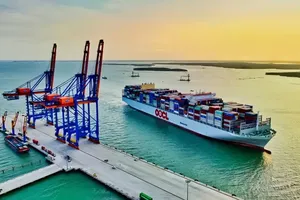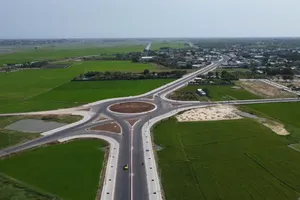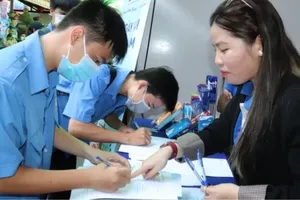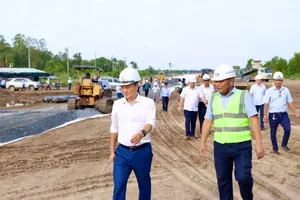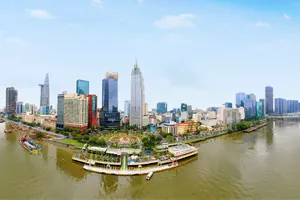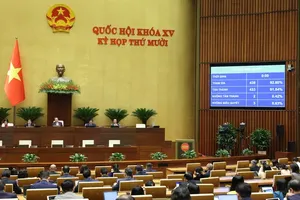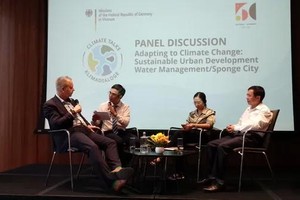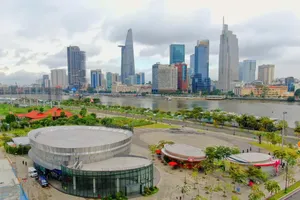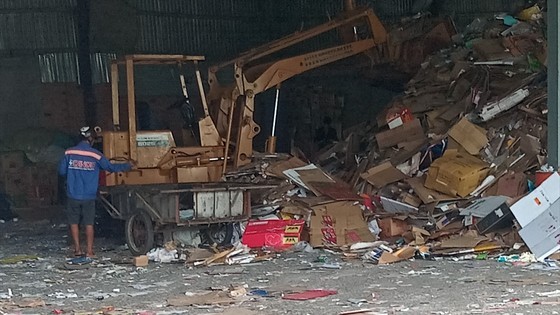 |
High fire and explosion risks at scrap trading points like this one in Tan Tao A Ward of Binh Tan District |
For a long time in HCMC, the model of combining accommodation and business or production facilities is extremely popular, especially in the suburb. They can be in different fields of scrap trading, aluminium – stainless steel door welding, fabric dyeing, or wood processing. Since they are rather small and built close to one another without proper fire prevention or environmental protection methods, they pose a high risk of explosion, fire, or pollution.
Therefore, it is advisable to relocate these dangerous companies out of residential areas, lessening that risk and contributing to creating a cleaner environment for dwellers while helping them stabilize their operations for a more sustainable growth.
HCMC has introduced several support policies for small production facilities with a high risk of fire, explosion, and pollution to relocate themselves to more suitable places.
Deputy Head Pham Thanh Truc of the Management Board of HCMC Exporting Processing and Industrial Zones (HEPZA) said that relocated companies to industrial parks can enjoy preferential land rent rates, aids in administrative procedures related to land use, investment registration, construction, and environment protection methods. Moreover, they can use the existing water and common sewage processing systems.
“HCMC has directed the industrial parks of Pham Van Hai, Le Minh Xuan (expanded), Tan Phu Trung, and Hiep Phuoc (phase 2) to accept these relocated production facilities in the near future”, informed Deputy Head Truc. Yet since the remaining land resources of the city is not much, moving them to industrial parks in neighboring provinces is also a wise choice, considering that the inter-regional traffic network has been improved lately.
Deputy Director Nguyen Thi Thanh My of the HCMC Department of Natural Resources and Environment stated that her organization has already proposed to HCMC People’s Committee about collaboration between the Planning & Architecture Department and the Industry & Trade Department to develop an investment attraction plan for approved industrial clusters with proper infrastructure so that needy production facilities can move there for long-term stability and pollution addressing.
Deputy Director My added that HCMC People’s Committee has been suggested to tighten its monitoring and inspection over the environment protection task of all production facilities in the city, particularly those having received many reports from local residents. Meanwhile, the HCMC Department of Natural Resources and Environment is going to cooperate with related state agencies to help those companies to upgrade their production technologies and machines for less pollution.
Dr. Dinh Thi Thanh Nga from the Law Faculty of Sai Gon University shared that HCMC should consider the task of relocating polluted production facilities out of residential areas an urgent one regardless of many challenges (mostly financial issues) on the way. The city needs master planning for its industrial clusters, cottage industrial zones, along with appropriate support policies on land rent rates, loan packages so as to encourage small production facilities to move there. However, it is not wise to force the relocation when new places are not ready for them.
Assoc. Prof. Dr. Phung Chi Sy from the Vietnam Association for Conservation of Nature and Environment (VACNE) stressed that HCMC must first update the list of current production facilities sited inside residential areas, especially polluted ones in the fields of fabric weaving and dyeing, cattle raising and slaughtering. Following that is the classification step. Concerned companies can either relocate themselves, or change to other work, or upgrade production technologies. Meanwhile, industrial clusters must complete their infrastructure preparation (proper surface area, full utilities) to welcome these facilities. This can stop the situation of moving a polluted company from this to another temporary place, which is a waste of time and finance.
Assoc Prof. Dr. Nguyen Hong Quan – Head of the Institute for Circular Economy Development (ICED) in Vietnam National University-HCM said that the case of a relocated production facility being surrounded by new residential areas now shows either improper planning of HCMC or wrong implementation of that planning due to a lack of resources, supervision. Therefore, the city needs a comprehensive report on which fields should be relocated, along with corresponding new places.
In addition, it is necessary to discuss with concerned production facilities about their choices for these new places. Like it or not, these polluted companies have also contributed to the economic growth of HCMC so far, which should be appreciated. The city must have suitable locations to welcome each type of industry instead of gathering them all into one place. Those facilities that do not want to move can be helped to upgrade their production technologies and machines as well as better observance of applicable laws. Synchronous implementation of these measures will provide long-term benefits for both the city and the companies themselves.
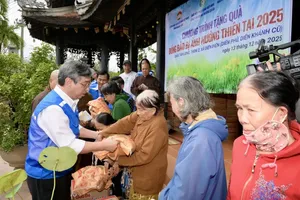


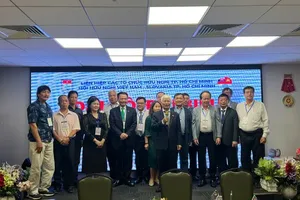
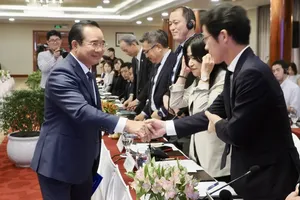
)
